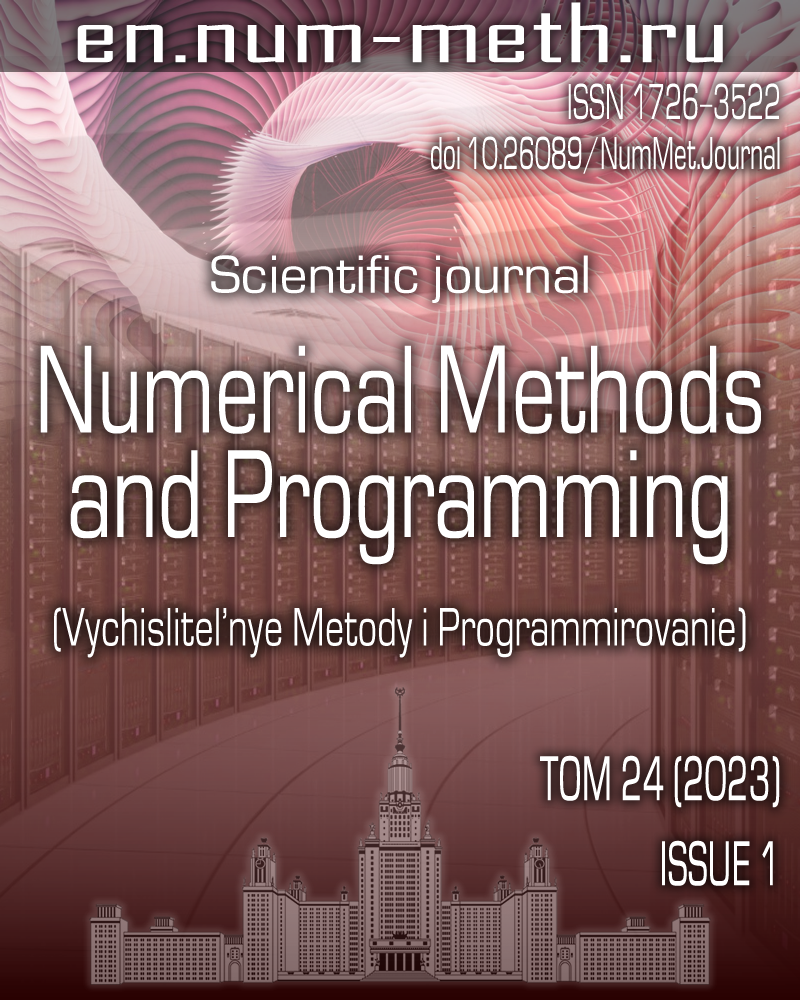DOI: https://doi.org/10.26089/NumMet.v24r105
Parallel implementation of a seismic source recovery algorithm from a series of statistically identical media models using Fortran Coarray
Keywords:
Abstract
The research considers the problem of parallel implementation of an algorithm for determining a seismic source inside a randomly heterogeneous medium. The algorithm for determining the initial position of the source uses the data of recorded seismograms on the free surface and information about the statistical properties of the random environment. The proposed approach requires solving a large number of problems in the dynamic theory of elasticity for various statistically equivalent velocity models identified by the statistical parameters of the initial medium. This is the most time-consuming part of the solution algorithm. To speed up calculations, a twolevel parallelization strategy is used by creating groups, each of which solves its problem of dynamic elasticity theory with a decomposition of the computational domain within the group. Program implementation uses Fortran Coarray. It also compares the used Fortran Coarray extension constructs with MPI functions.
Published
Issue
Section
References
- C. Yoshimura, J. Bielak, Y. Hisada, and A. Fernández, “Domain Reduction Method for Three-Dimensional Earthquake Modeling in Localized Regions, Part II: Verification and Applications,” Bull. Seismol. Soc. Am. 93 (2), 825-841 (2003).
doi 10.1785/0120010252.
https://www.crossref.org/iPage?doi=10.1785 - P. Moczo, J. Kristek, M. Galis, et al., “3-D Finite-Difference, Finite-Element, Discontinuous-Galerkin and Spectral-Element Schemes Analysed for Their Accuracy with Respect to P-Wave to S-Wave Speed Ratio,” Geophys. J. Int. 187 (3), 1645-1667 (2011).
doi 10.1111/j.1365-246X.2011.05221.x. - B. Fornberg, “The Pseudospectral Method: Accurate Representation of Interfaces in Elastic Wave Calculations,” Geophysics. 53 (5), 625-637 (1988).
doi 10.1190/1.1442497.
https://library.seg.org/doi/10.1190/1.1442497. - H. Takenaka, Y. Wang, and T. Furumura, “An Efficient Approach of the Pseudospectral Method for Modelling of Geometrically Symmetric Seismic Wavefield,” Earth Planets Space 51 (2), 73-79 (1999).
doi 10.1186/BF03352212.
https://earth-planets-space.springeropen.com/articles/10.1186/BF03352212. - E. Chaljub, D. Komatitsch, J.-P. Vilotte, et al., “Spectral-Element Analysis in Seismology,” Adv. Geophys. 48, 365-419 (2007).
doi 10.1016/S0065-2687(06)48007-9.
https://www.sciencedirect.com/science/article/abs/pii/S0065268706480079. - P. Moczo, J. Kristek, and L. Halada, “3D Fourth-Order Staggered-Grid Finite-Difference Schemes: Stability and Grid Dispersion,” Bull. Seismol. Soc. Am. 90 (3), 587-603 (2000).
doi 10.1785/0119990119.
https://www.crossref.org/iPage?doi=10.1785 - J. Virieux, “P-SV Wave Propagation in Heterogeneous Media: Velocity-Stress Finite-Difference Method,” Geophysics. 51 (4), 889-901 (1986).
doi 10.1190/1.1442147.
https://library.seg.org/doi/10.1190/1.1442147. - A. R. Levander, “Fourth-Order Finite-Difference P-SV Seismograms,” Geophysics 53 (11), 1425-1436 (1988).
doi 10.1190/1.1442422.
https://library.seg.org/doi/10.1190/1.1442422. - E. Tessmer, “Seismic Finite-Difference Modeling with Spatially Varying Time Steps,” Geophysics. 65 (4), 1290-1293 (2000).
doi 10.1190/1.1444820.
https://library.seg.org/doi/10.1190/1.1444820. - P. Moczo, J. Kristek, V. Vavrycuk, et al., “3D Heterogeneous Staggered-Grid Finite-Difference Modeling of Seismic Motion with Volume Harmonic and Arithmetic Averaging of Elastic Moduli and Densities,” Bull. Seismol. Soc. Am. 92 (8), 3042-3066 (2002).
doi 10.1785/0120010167.
https://pubs.geoscienceworld.org/ssa/bssa/article-abstract/92/8/3042/103016/3D- - M. Dumbser, M. Käser, and J. De La Puente, “Arbitrary High-Order Finite Volume Schemes for Seismic Wave Propagation on Unstructured Meshes in 2D and 3D,” Geophys. J. Int. 171 (2), 665-694 (2007).
doi 10.1111/j.1365-246X.2007.03421.x.
https://academic.oup.com/gji/article/171/2/665/656710. - D. Peter, D. Komatitsch, Y. Luo, et al., “Forward and Adjoint Simulations of Seismic Wave Propagation on Fully Unstructured Hexahedral Meshes,” Geophys. J. Int. 186 (2), 721-739 (2011).
doi 10.1111/j.1365-246X.2011.05044.x.
https://academic.oup.com/gji/article/186/2/721/590417. - P. Cupillard, E. Delavaud, G. Burgos, et al., “RegSEM: A Versatile Code Based on the Spectral Element Method to Compute Seismic Wave Propagation at the Regional Scale,” Geophys. J. Int. 188 (3), 1203-1220 (2012).
doi 10.1111/j.1365-246X.2011.05311.x.
https://academic.oup.com/gji/article/188/3/1203/686715. - V. I. Kostin, V. V. Lisitsa, G. V. Reshetova, and V. A. Tcheverda, “Finite Difference Simulation of Elastic Waves Propagation through 3D Heterogeneous Multiscale Media Based on Locally Refined Grids,” Sib. Zh. Vych. Mat. 16 (1), 45-55 (2013) [Numer. Anal. Appl. 6 (1), 40-48 (2013)].
doi 10.1134/S1995423913010059.
https://link.springer.com/article/10.1134/S1995423913010059. - M. Fink, “Time Reversal in Acoustics,” Contemp. Phys. 37 (2), 95-109 (1996).
doi 10.1080/00107519608230338.
https://www.tandfonline.com/doi/abs/10.1080/00107519608230338. - M. Fink, “Time Reversed Acoustics,” Phys. Today 50 (3), 34-40 (1997).
doi 10.1063/1.881692.
https://physicstoday.scitation.org/doi/10.1063/1.881692. - M. Fink, G. Montaldo, and M. Tanter, “Time-Reversal Acoustics in Biomedical Engineering,” Annu. Rev. Biomed. Eng. 5, 465-497 (2003).
doi 10.1146/annurev.bioeng.5.040202.121630.
https://www.annualreviews.org/doi/abs/10.1146/annurev.bioeng.5.040202.121630. - G. Reshetova, V. Cheverda, and V. Koinov, “Comparative Efficiency Analysis of MPI Blocking and Non-blocking Communications with Coarray Fortran,” in Communications in Computer and Information Science (Springer, Cham, 2021), Vol. 1510, pp. 322-336.
doi 10.1007/978-3-030-92864-3_25.
https://link.springer.com/chapter/10.1007/978-3-030-92864-3_25. - R. W. Graves, “Simulating Seismic Wave Propagation in 3D Elastic Media Using Staggered-Grid Finite Differences,” Bull. Seismol. Soc. Am. 86 (4), 1091-1106 (1996).
doi 10.1785/BSSA0860041091.
https://pubs.geoscienceworld.org/ssa/bssa/article-abstract/86/4/1091/120141/ - F. Collino and C. Tsogka, “Application of the Perfectly Matched Absorbing Layer Model to the Linear Elastodynamic Problem in Anisotropic Heterogeneous Media,” Geophysics 66 (1), 294-307 (2001).
doi 10.1190/1.1444908.
https://www.researchgate.net/publication/228544899_Application_ - H. Sato, M. C. Fehler, and T. Maeda, Seismic Wave Propagation and Scattering in the Heterogeneous Earth (Springer, Berlin, 2012).
doi 10.1007/978-3-642-23029-5.
https://link.springer.com/book/10.1007/978-3-642-23029-5. - H. A. Schwarz, “Über einige Abbildungsaufgaben,” J. für die Reine und Angew. Math. 1869 (70), 105-120 (1869).
doi 10.1515/crll.1869.70.105.
https://eudml.org/doc/148076. - S. L. Sobolev, “Schwarz’s Algorithm in Elasticity Theory,” in Selected Works of S.L. Sobolev (Springer, Boston, 2006), pp. 399-403.
doi 10.1007/978-0-387-34149-1_12.
https://link.springer.com/chapter/10.1007/978-0-387-34149-1_12. - J. Reid, “The New Features of Fortran 2018,” ACM SIGPLAN Fortran Forum 37 (1), 5-43 (2018).
doi 10.1145/3206214.3206215.
https://dl.acm.org/doi/abs/10.1145/
License
Copyright (c) 2023 В. В. Койнов

This work is licensed under a Creative Commons Attribution 4.0 International License.


